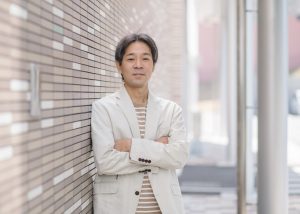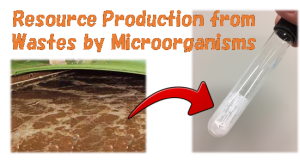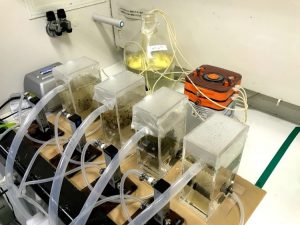Daisuke INOUE

Position: Associate Professor
Degree: Ph.D.
Laboratory: Bio-Environmental Engineering Laboratory
to Laboratory Homepage
Environmental remediation/conservation and resource/energy recovery through the rational control of the microbial community
There are a variety of microorganisms in the environment that have beneficial functions for human beings. Our research group is attempting to scientifically understand these beneficial functions and to develop technologies and systems to rationally utilize the microbial functions for environmental remediation/conservation and resource/energy recovery. Specifically, since a variety of microorganisms coexist with mutual interactions in the environment, we aim to control the fate of the microbial community for any given purpose.
Resource production from waste-activated sludge and wastewater
Wastewater treatment employing activated sludge processes has significantly contributed to the improvement and maintenance of the quality of water environments and to the mitigation of environmental risks for humans and other animals. However, it inevitably generates a large amount of waste activated sludge that has to be disposed of. Beneficial use for the sludge is thus strongly desired for contribution toward a low-carbon/sustainable society. In view of this, our research group is exploring the production of value-added resources using waste activated sludge as the biocatalyst. Specifically, we are focusing on the production of polyhydroxyalkanoates (PHAs) through the combined use of the catalytic functions inherent in waste activated sludge and soluble organic substances in wastewater. PHAs are the only bioplastic material entirely synthesized by microorganisms, and are wholly biodegradable and biocompatible thermoplastic substances. The development of the practical technology will provide multiple benefits, including the reduction of the energy and cost required for waste treatment (waste-activated sludge and wastewater), and the mitigation of global warming and ocean microplastic pollution.
Our overall idea can be encapsulated as follows: “minus (waste activated sludge) times minus (wastewater) is a plus (value-added resource).”

PHA production using waste activated sludge as the biocatalyst
Wastewater treatment and environmental remediation using special microorganisms
The release of anthropogenic chemical compounds utilized in industries and our daily lives can cause environmental pollution and consequently poses environmental risks to humans and wild animals. In contrast, certain microorganisms in the environment can degrade even recalcitrant compounds and utilize them for growth. Our research group is exploring the development of technologies for treating recalcitrant compounds using these special microorganisms. One of our target compounds is 1,4-dioxane, which is a pollutant of emerging concern in aquatic environments due to its stable physicochemical properties in water and its suspected carcinogenicity. We have isolated taxonomically and functionally different bacterial strains capable of degrading 1,4-dioxane from environmental samples and are characterizing their 1,4-dioxane degradation mechanisms and properties. In addition, we are developing biological technologies for removing the 1,4-dioxane in wastewater, landfill leachate, and groundwater through bioaugmentation and biostimulation.

Biological treatment of 1,4-dioxane-containing wastewater
Publication
- Inoue D., Hisada K., Okumura T., Yabuki Y., Yoshida G., Kuroda M., Ike M.: Carbon sources that enable enrichment of 1,4-dioxane-degrading bacteria in landfill leachate. Biodegradation in press.
- Inoue D., Tsunoda T., Sawada K., Yamamoto N., Sei K., Ike M.: Stimulatory and inhibitory effects of metals on 1,4-dioxane degradation by four different 1,4-dioxane-degrading bacteria. Chemosphere 238, 124606 (2020).
- Inoue D., Fukuyama A., Ren Y., Ike M.: Rapid enrichment of polyhydroxyalkanoate-accumulating bacteria by the aerobic dynamic discharge process: Enrichment effectiveness, polyhydroxyalkanoate accumulation ability, and bacterial community characteristics in comparison with the aerobic dynamic feeding process. Bioresource Technology Reports 7, 100276 (2019).
- Toyama T., Kasuya M., Hanaoka T., Kobayashi N., Tanaka Y., Inoue D., Sei K., Morikawa M., Mori K.: Growth promotion of three microalgae, Chlamydomonas reinhardtii, Chlorella vulgaris and Euglena gracilis, by in situ indigenous bacteria in wastewater effluent. Biotechnology for Biofuels 11, 176 (2018).
- Inoue D., Sawada K., Tsutsui H., Fujiwara T.: Identification of microbial populations contributing to nitrification-associated nitrous oxide emission during cattle manure composting process with forced aeration. Journal of Material Cycles and Waste Management 20, 353-360 (2018).